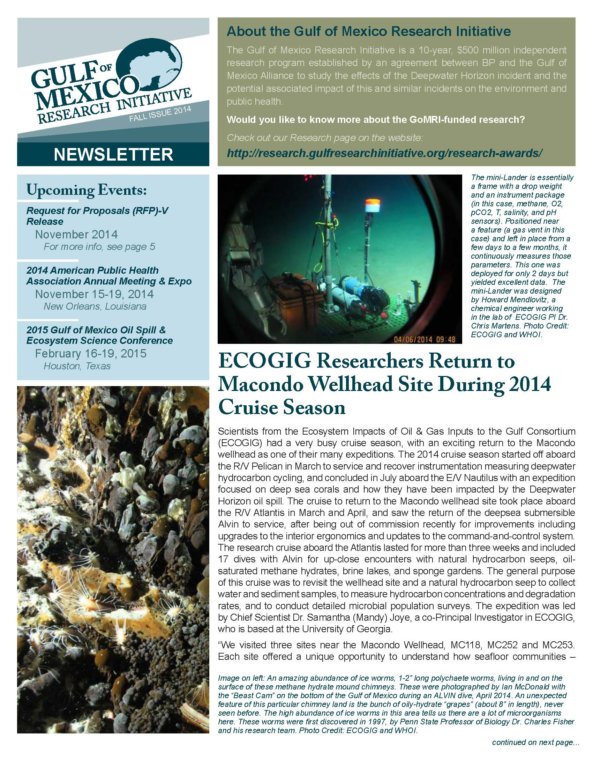GoMRI Newsletter: Fall Issue 2014
Download Full Issue (PDF)
Above the Fold
– “ECOGIG Researchers Return to Macondo Wellhead Site During 2014 Cruise Season”
– “GoMRI Presents Award at Intel International Science and Engineering Fair, May 11-15”
– “Teens Explore Oil Spill Impacts on Wetlands through Science and Art”
– Frequently Asked Questions by Dr. Chuck Wilson
– Note from the Research Board Chair
– Education Spotlight
– GoMRI Researcher Interview with Dr. Joseph Neigel
Community Happenings
Science Corner
Published Science Highlights from the GoMRI Program
Study Makes Storm Surge Predictions at Less Cost without Sacrificing Accuracy
Kyle T. Mandli and Clint N. Dawson
Ocean Modelling, 2014, 75, 36–50
Study Shows Oil Promoted Formation of a Different Kind of Marine Snow>
Uta Passow, Kai Ziervogel, Vernon Asper, and Arne Diercks
Environmental Research Letters 2012: 7 035301
Study: Dispersant Increases Oil Compounds Entering Atmosphere via Bursting Bubbles
Franz S. Ehrenhauser, Paria Avij, Xin Shu, Victoria Dugas, Isaiah Woodson, Thilanga Liyana-Arachchi, Zenghui Zhang, Francisco R. Hung, and Kalliat T. Valsaraj
Environ. Sci.: Processes Impacts, 2014, 16, 65-73
Study Evaluates Synthetic Aperture Radar as Oil Spill Detection Tool
M.J. Caruso, M. Migliaccio, J.T. Hargrove, O. Garcia-Pineda, and H.C. Graber
Oceanography, 2013, 26 (2): 112-123
Study Identifies Potential Oil Degradation Signal in Coastal Waters
Xinping Hu, Wei-Jun Cai, Nancy N. Rabalais, and Jianhong Xue
Deep Sea Research II: Topical Studies in Oceanography, 2014: 1-8
To see all GoMRI publications, please visit the GoMRI Publication Database.
Video Clip of the Quarter
Check out this video from the recent Nautilus expedition, where ECOGIG researchers use an ROV to deploy a dye pack that will help them measure coral growth. Unstained coral will show new growth when the scientists return to measure it next year.
The video can be seen here and a blog post about the experiment can be found here.
GoMRI Newsmakers
Congratulations to the following member of the GoMRI Community
Congratulations go out to Dr. Howard Stone, a professor in Mechanical and Aerospace Engineering at Princeton University, for his election into the National Academy of Sciences (NAS). Stone joins GoMRI Research Board Chair Rita Colwell as an NAS member. An invitation to join the ranks of the NAS is one of the highest distinctions that an American scientist or engineer can receive.
Dr. Stone, a specialist in fluid mechanics and a member of the GoMRI-funded Consortium for the Molecular Engineering of Dispersant Systems (C-MEDS), is collaboratively working on the ultrafast dynamics of surfactant adsorption to interfaces that could ultimately lead to improvements in oil spill cleanup and degradation. In particular, Dr. Stone’s group is studying the dynamics of bursting at an oil- covered interface and producing nanometer-diameter sized oil droplets dispersed in the water column.
GoMRI Scholars in Action
Graduate Students Recognized as GoMRI Scholars for Oil Spill Research
The Gulf of Mexico Research Initiative (GoMRI) announces their Scholars Program to recognize the graduate students whose vital research contribute to improve understanding about the damage, response, and recovery following the Deepwater Horizon oil spill. One of the GoMRI Legacy Goals is to build intellectual capacity and improve fundamental understanding of the dynamics of petroleum pollution and related stressors for future events. Research Board Chair Rita Colwell said that “the GoMRI Scholars Program is a very important honor which provides a unique recognition of and builds community for the next generation of ocean science professionals with particular emphasis in the Gulf of Mexico.”
Candidates for this program must be graduate students who have participated in a GoMRI-funded project for at least one year, whose work is primarily funded by GoMRI, and who are working on a dissertation or thesis based on GoMRI-funded science. On a semi-annual basis, the Principal Investigators of GoMRI-funded projects nominate students who meet these criteria.
Following confirmation, each scholar will receive a letter of congratulations declaring the title GoMRI Scholar along with a certificate from Dr. Colwell. In addition, special events of interest to GoMRI Scholars will be incorporated into the annual Gulf of Mexico Oil Spill and Ecosystem Sciences conference. GoMRI will collect information about these scholars and their careers and accomplishments for longitudinal studies and program impacts.
As of March 2014, Directors for the eight Research Consortia have selected 137 students as GoMRI Scholars. Principle Investigators for the nineteen Investigator Grants are in the process of selecting their scholars.
Learn more about the scholars’ research and career paths on the GoMRI website:
- Grad Student Saha Makes Strides towards an Eco-friendly Dispersant Alternative
- Grad Student Vozzo Assesses Oil Impacts on Louisiana Oysters
- Grad Student Frasier is Learning What Dolphins Can Tell Us
- Grad Student Snyder Cites Integrated Sciences as Key to Success
- Grad Student Worthen Improves Oil Production and Cleanup Using Nanoparticles
- Grad Student Harper Seeks to Improve Marine and Human Health with Science-Informed Policy
Ocean Portal
GoMRI has partnered with the Smithsonian Institution to help share GoMRI research findings with the broad public audience that visits the Ocean Portal for information on all things ocean-related. The Ocean Portal has highlighted various GoMRI research topics, from how drifters are being used to better understand ocean currents and refine models that will help in future oil spill response efforts, to how small organisms like benthic foraminifera were impacted by the spill.
The Ocean Portal also described some of the misconceptions that persist about the spill and its impacts, and used GoMRI research findings to clear them up. That article can be found on Smithsonian Magazine online. The Portal will soon be publishing an interactive infographic, allowing site visitors the opportunity see information presented in a visually compelling way to understand the event as it first occurred, how different parts of the Gulf were impacted, and what is going on now, more than four years after the spill occurred. Check out the Ocean Portal’s GoMRI content.

